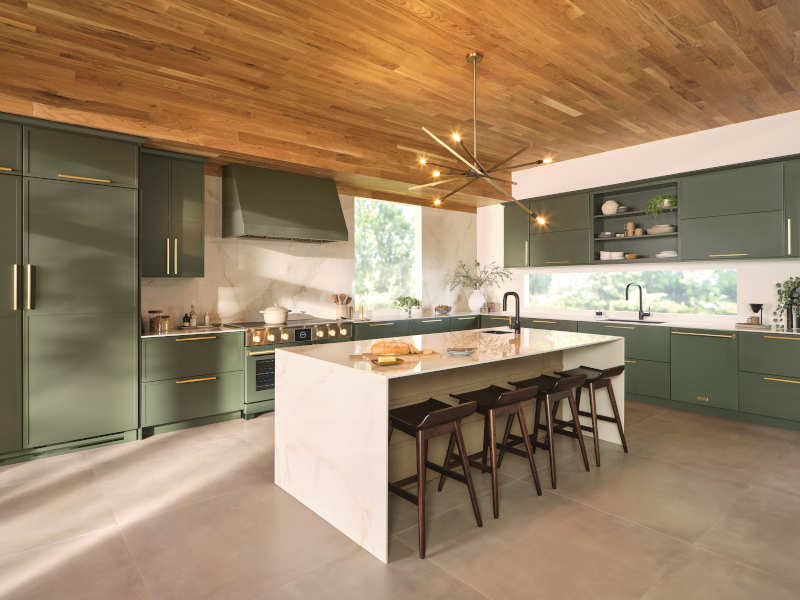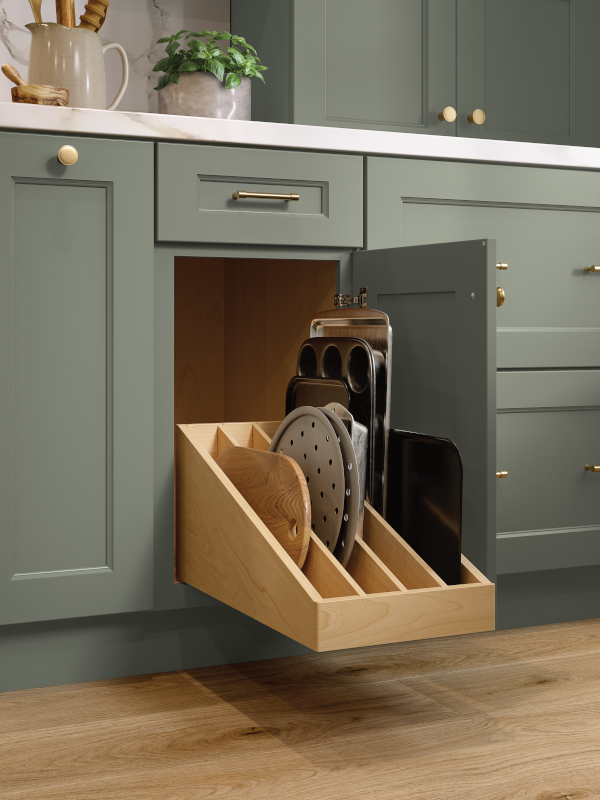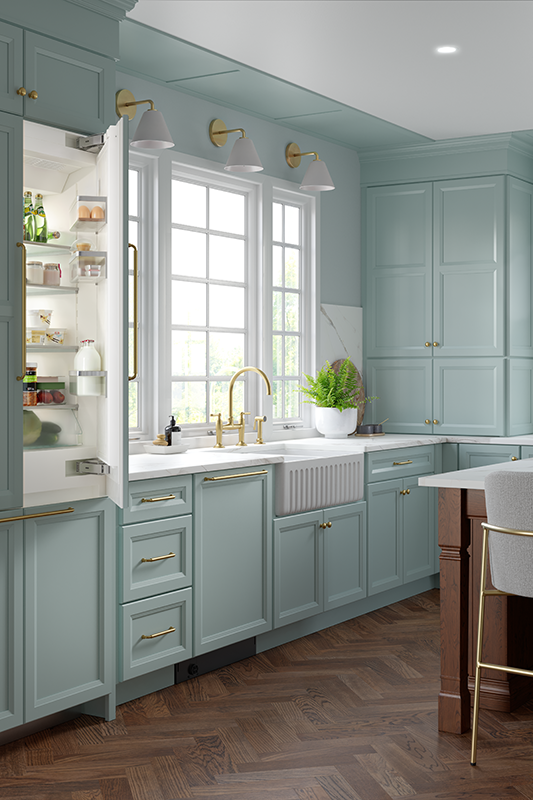The homeowner’s guide to new kitchen cabinets

Your kitchen is ready for a modern update, and now it’s time to plan your remodel. A kitchen remodel involves many decisions, from layout and lighting to appliances and finishes, but one of the most significant choices is selecting new kitchen cabinets.
Cabinets serve as both functional and visual anchors, generally representing the largest portion of your remodel budget. The right cabinets can transform how your kitchen looks, feels, and functions - making everyday tasks easier while reflecting your personal style. They’re truly the backbone of an efficient kitchen.
Partnering with a kitchen designer can simplify the process. A designer helps you navigate choices, optimize your layout, and select cabinets that balance style, function, and budget. Tools like the Rebode Jumpstarter style quiz create a personalized style profile that we share with kitchen designers, helping you get started on your remodel journey with confidence.
In this guide, we cover everything homeowners need to know about choosing new kitchen cabinets, helping you make confident decisions that align with your style, lifestyle, and the character of your home.
Stock, Semi-Custom, and Premium Cabinets Explained
If you want to personalize your kitchen cabinetry, understanding cabinet grades is key. Each grade reflects a different level of quality, craftsmanship, and investment. Knowing the cabinet grade differences empowers you to choose cabinets that fit within your budget while supporting your long-term design goals, ensuring a kitchen that is both beautiful and functional for many years to come.
- Stock (premade) cabinets: Manufactured in standard sizes, stock cabinets are the most cost-effective option. While style and finish choices are limited, they’re often available for immediate or fast delivery.
- Semi-custom cabinets: Built to order through cabinet dealers, semi-custom cabinets offer a balance between affordability and personalization. They provide a wider variety of door styles, finishes, and features, with typical delivery between 4–8 weeks.
- Premium cabinets: Designed and crafted by skilled artisans, custom cabinets offer you complete control over layout, materials, and detailing. While they represent the highest investment, they provide unmatched personalization and long-term durability.
You may be weighing these options alongside other factors such as material quality, construction methods, and brand reputation. While the decision is ultimately yours, a kitchen designer can guide you in the process - integrating cost, personalization, and long-term durability to create a space fit for your lifestyle.

Function and style, perfectly paired in premium cabinetry. Photo from MasterBrand Cabinets.
Exploring wood options and durability
Your choice of cabinet wood species does more than set the visual tone of your kitchen - it also influences durability. Upgrading to new kitchen cabinets improves how well your kitchen holds up over time, from daily wear and tear to long-term use, while also bringing lasting style. Each wood species has unique characteristics

Once you’ve chosen a wood species, the next step is selecting a color and finish. Talk with your designer about how a specific stain or paint will look on that type of wood. Request a sample to see how the color looks in your space, feel the texture, watch the grain interact with the finish and light, and evaluate how it will perform in a busy kitchen. We’ll dive deeper into this below!
Choosing new kitchen cabinet color or stain
The color of your new kitchen cabinets ties the room together. Yet, choosing the right shade for your wood, medium-density fiberboard (MDF), metal, or laminate cabinets can leave homeowners uncertain: Which colors will stand the test of time? How will they complement your floors, countertops, and appliances?
Center your kitchen cabinet color approach around style, practicality, and longevity - while keeping in mind that available finishes and colors often vary by cabinet grade. Light, neutral tones on cabinets can make your space feel open and airy, while darker shades add warmth and sophistication.
Pro tips for creating a kitchen that reflects you:
- Test the color and see how it shifts with lighting throughout the day.
- Durable finishes perform best for high-trafficked kitchens that see a lot of fingerprints, scratches, and fading due to an abundance of natural light.
- Select shades that complement your home’s charm to ensure the color ages gracefully.
- Factor in accents like hardware, countertops, and backsplashes to showcase your new kitchen cabinets.
With a thoughtful approach, your color and finishing stain can combine visual appeal and lasting functionality, resulting in a kitchen that feels both purposeful and inviting.
Maximizing function in a remodel
New kitchen cabinets are designed with both functionality and accessibility in mind. Homeowners want cabinets that look beautiful, but also make cooking, cleaning, and storage easier and more efficient.
Well-designed cabinets maximize space and reduce clutter—whether through soft-close drawers for a quieter household, pull-out shelves for better organization and accessibility, or custom inserts for cookie sheets, pots, pans, and small appliances. Even awkward or hard-to-reach areas can be made into usable storage with solutions like corner carousels, pull-out trays, or vertical dividers.
Functional cabinets improve daily workflow, keep essentials within reach, and adapt to the way you live. By prioritizing functionality, you ensure your cabinets work as hard as you do, creating a kitchen that is both practical and enjoyable to use.

Pull-out dividers place your pans and cutting boards exactly where you need them, saving time and effort in the kitchen. Photo from MasterBrand Cabinets.
Measuring for new cabinetry
Doing some kitchen pre-measuring can help you prepare for your kitchen remodel and better communicate your vision. Roughly noting wall lengths, cabinet spaces, and window dimensions gives you a clear sense of your current layout, so you and your designer can explore what’s possible together. This step isn’t about exact measurements—it’s about visualizing your kitchen in 3D on your mobile device (available on iPhones 12 and later and iPads with LiDAR scanners) and translating your ideas into a plan your designer can refine.
As you take notes, think about how you naturally move through your kitchen—where you prep, cook, and clean—and where you’d like the pots, pantry goods, or small appliances to be stored. Sharing these priorities gives your designer a clear starting point for creating a cabinet plan that reflects both your style.
From there, your designer will handle the precise measurements and technical details, ensuring every cabinet is tailored to fit seamlessly and support the way you live.
Budgeting for cabinets without surprises
Kitchen cabinets often represent around 30% of a remodel budget, which can feel overwhelming. Understanding where costs come from—and how to prioritize—helps you stay in control of the process. Cabinet pricing is influenced by the wood species, level of customization, and hardware choices. The more tailored your cabinets, the higher the investment, while semi-custom options often balance evenly between style, function, and cost.
Your designer can make these decisions easier. They can guide you toward options that align with your goals without compromising on quality or aesthetics. By setting clear priorities and approaching choices with transparency, you can make confident decisions, stay on budget, and create cabinets that feel worthwhile for both your lifestyle and your home.

Your designer can help you stay within budget while creating cabinets that deliver style, function, and lasting value.
Long-lasting cabinets enhance home value
Quality cabinets are a long-term investment—built to last, improve your kitchen’s functionality, and add lasting value to your home. Homeowners who have remodeled before recommend prioritizing functionality and allocating more of the budget to durable materials that stand up to daily life. Well-constructed cabinetry with timeless design lasts for decades, protecting you from costly replacements and keeping your kitchen efficient and enjoyable.
Updated kitchens can also carry a resale benefit. Even if you’re not planning to sell right away, new cabinets are one of the first things home buyers notice. A kitchen that feels well-maintained and thoughtfully designed can significantly boost your home’s appeal. Choosing neutral, versatile styles and durable finishes ensures your kitchen works beautifully today while also positioning your home as a smart, long-term investment.
Bring style and function to your kitchen
Selecting new kitchen cabinets is one of the most impactful decisions in your remodel. From choosing the right wood to finishes and functional design, your cabinets define how your kitchen looks, feels, and works. The key is making choices that match your lifestyle so your kitchen isn’t just beautiful, but practical, durable, and most of all, uniquely yours.
Ready to start planning your dream kitchen? Take the Rebode Jumpstarter style quiz to discover your cabinet style preferences and meet with a local kitchen designer to explore materials that bring function and personality to your space. Create a kitchen that works as hard as you do—explore layouts, finishes, and design ideas today.